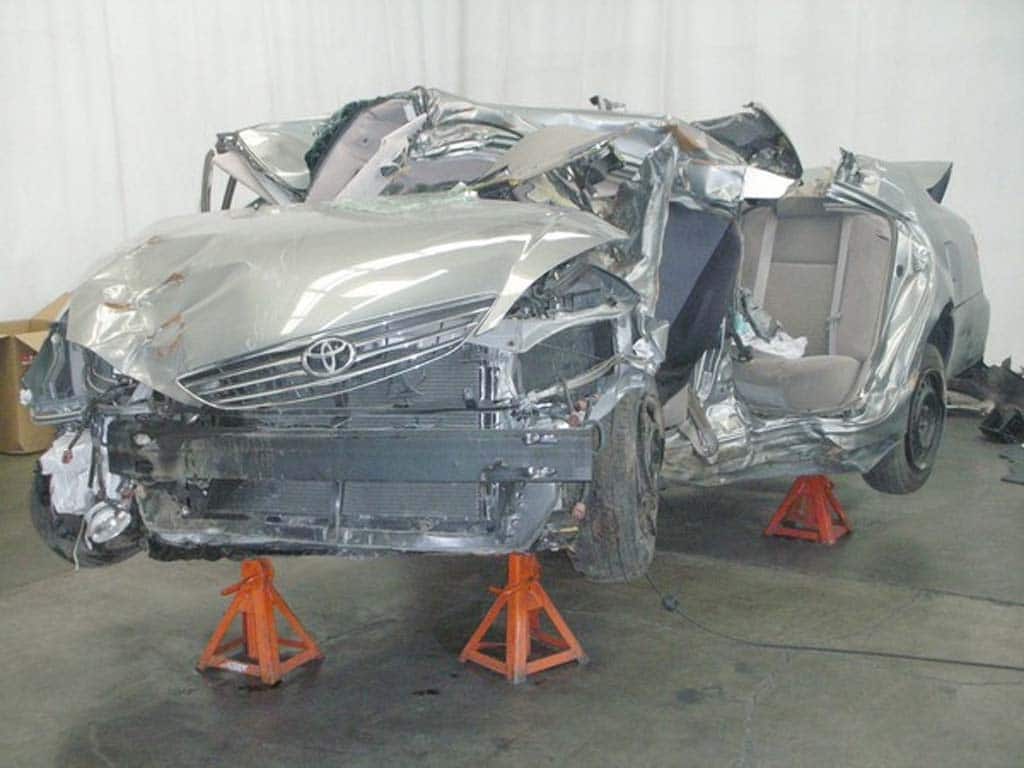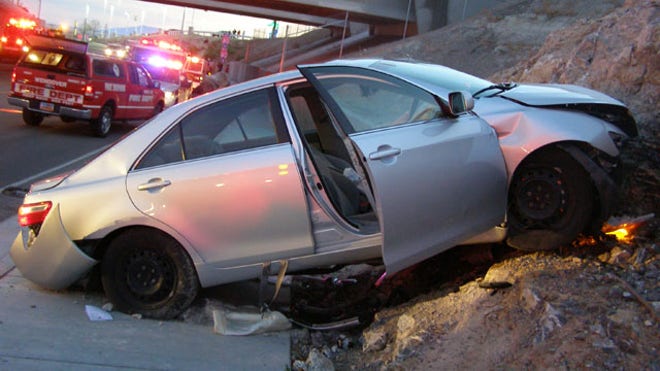This 4 year-old cherub is Lily Quintus who was killed when a TOYOTA SOLARA slammed into her Day Care.
This RUN-AWAY TOYOTA SOLARA slammed into Lily's Day Care.
Florida Highway Patrol officers are measuring the skid marks left by the driver of the TOYOTA SOLARA as he attempted to stop.
This nice lady is Noriko Uno.
Her TOYOTA ACCELERATED after being struck by another vehicle, witnesses indicated they saw brake lights.
TOYOTA settled this case with a confidentiality agreement:
The crash on Nov.
5 killed Paul Van Alfen, 66, and his son's fiancee Charlene Lloyd, 38; Van
Alfen's wife and son were also injured in the wreck. Unlike similar crashes in
Toyotas later blamed on drivers mistaking the
accelerator for the brake, police say Van Alfen's Camry left skid
marks as it exited Interstate 80 near Wendover, Utah.
presumably from holding down the brake pedal. The Utah Highway Patrol said
Monday that based on statements from the passengers who survived, the
Camry's gas
pedal appeared stuck.
Van Alfen's Camry
had been covered by three recalls relating to sudden acceleration
problems, including floor mats and sticking pedals. While
investigators believe Van Alfen had brought his Camry in for the repairs, it's
not clear what fixes had been performed. Toyota has also said it was upgrading
2008 Camrys to include brake override systems designed to cut engine power if
the brake and accelerator are pressed simultaneously; and once again, it's not
clear whether that upgrade was performed.
The Saylor Family was killed when their OUT-OF-CONTROL LEXUS burst into flames.
This is the Lexus RX 350 that belonged to Hyekyong Lee.
The Lexus RX 350 ACCELERATED and went through the front of her business.
This nice lady planned to spend the rest of her life with her husband.
This gentle man, Koua Fong Lee went to prison when his RUN-AWAY TOYOTA killed others.
Only the commitment, generosity and dedication of strangers freed him to be with his family.
[READ: Trudy Baltazar's book: A Road To Freedom]
Suddenly, in POPS a PROPAGANDIST or two....
with their next LOGIC DEFYING SMOKE SCREEN....
Oh! YES! Instead of FIXING THEIR DEFECTIVE VEHICLES, the likes of TOYOTA, already admitted LYING AND CONCEALING KNOWN DEFECTS.....are going to PROMOTE.....
GET READY FOR THIS....DISTRACTED DRIVING! WITH NO EVIDENCE!
If you accept that illogic, how do you explain that the NATIONAL CAR WASH ASSOCIATION KNOWS WHICH VEHICLE ARE PRONE TO SUDDEN UNINTENDED ACCELERATION?
Bob Schrum, the owner of Flagstop Car Wash, said his employees are provided a list of cars, trucks and SUVs that have been proven prone to unintentional acceleration. In fact, he said the instances have been well documented by the National Car Wash Association.Schrum said about a month ago that all 120 of his employees took part in a safety seminar provided by his insurance company, which touched on sudden unintentional acceleration.
FROM:
Car Washes KNOW, but Consumers Don't?
Mr. Schrum's INSURANCE COMPANY KNOWS which vehicles are PRONE TO SUDDEN UNINTENDED ACCELERATION.
Isn't that the same bogus argument TOYOTA used in the past?
There is no evidence that this PROPAGANDIST is tracking the MAKE, MODEL and YEAR of these vehicles.
The Overlooked Threat of Vehicle-Into-Building Accidents
Many of these crashes are a result of driver error and often occur because businesses tend to orient themselves toward the street or parking lot, with their entrances facing forward for maximum visibility. Unfortunately, this design strategy creates vulnerabilities and, even though there are simple solutions, the problem persists because of lack of awareness, applicable building codes and the will to correct the situation.The following are some examples of such crashes from an eight-week period earlier this year:
- On March 1, 2014, an 88-year-old woman drove her Ford F-150 pickup truck through the front doors of a Food 4 Less grocery store in Las Vegas. Twenty-six people were hurt and nine hospitalized. One employee was dragged more than 200 feet through the store under the front bumper of the truck. Reports said that the driver mistook the gas pedal for the brake and accelerated into the store as she was driving toward the entrance. The driver was not cited.
- Less than two weeks later, hundreds of attendees were enjoying late night music events on a closed street at the popular South By Southwest Festival in Austin, Texas. A 21-year-old driver evading a DUI traffic stop turned a corner and drove through the temporary barricades at the end of the “closed” street, killing four and injuring two dozen. The driver is now facing capital murder charges and more than 20 counts of aggravated assault with a deadly weapon.
- On April 9, there was a minor collision on a street in Orlando, Florida. The car that was rear-ended somehow accelerated and travelled more than 100 feet, over a curb and through a parking area, before striking a KinderCare day care center filled with children and teachers. The car went through the wall and the facility, finally stopping because of the pile of furniture, debris and injured children in front of it. One young child was killed, and another 15 were injured. The investigation is ongoing.
- On April 25, a 74-year-old driver got into his car to leave Farrell’s Ice Cream Parlor in Buena Park, California. Instead of backing out of his parking space, he accelerated forward, jumping the concrete wheel stop and striking six people waiting to enter the busy restaurant. One woman was killed and several more hospitalized. The driver was not cited.
An Aging Population and Distracted Drivers
The Storefront Safety Council has been collecting data from various sources in an effort to quantify these types of accidents. Statistics consistently show that almost half of all storefront accidents are the result of pedal error, and that drivers with less than five years driving experience and drivers over 70 years old are most prone to committing such errors. Unfortunately, this sets the stage for a surge of these crashes in coming years.
Two trends are responsible for this potential increase. First, according to the demographics of aging in the United States, more than 10,000 Americans turn 65 years old every day. In 2012, there were about 23 million licensed drivers above the age of 70. By 2025, the number of drivers over 85 will have more than doubled. These drivers are the most prone to the types of errors resulting in vehicle-into-building crashes, so there is likely to be a corresponding upswing in these types of accidents.
The second trend is the increasing use of mobile technology. Recent data and highly publicized law enforcement efforts evidence the increase in distracted driving accidents, and inexperienced drivers have been shown to be the most easily distracted of all. While all drivers face smartphone distractions such as calls, texts, navigational aids and videos, younger drivers seem to be most prone to accidents when distracted due to their lack of experience.
Scope of the Problem
Most of these accidents occur on private property, making national or even local statistics difficult to find. While there are effective methods that can collect all manner of accident data on federal highways and mechanisms for collecting information from police reports on crashes on local streets, parking lot crashes are poorly quantified. The Storefront Safety Council has gathered data on more than 5,000 crashes in one of the largest ongoing databases of its kind in the country.
Working with the Texas Traffic Institute at Texas A&M University, researchers found that the 150,000 gas and convenience stores in the United States have a collective vehicle-into-building crash accident rate as high as 20 per day. The underlying data was obtained from anecdotal reports, media publications and actual company crash statistics made available as a result of legal proceedings. If each of these 7,300 accidents resulted in claims for property damage and personal injury claims of just $10,000, that adds up to an annual cost of more than $70 million for gas and convenience stores alone. When expanded to include all commercial buildings, the cost could swell to as much as $200 million per year.
While the number and severity of crashes into commercial buildings is surprising to many, it is not news to owners and operators of the businesses that are struck. The Storefront Safety Council has documented so many cases where drivers have driven into and through grocery stores that the entire industry is considered “on notice” to take corrective action or face increased liability and negligence claims.
In one personal injury lawsuit, the defendant retailer found that its 7,000-plus stores nationwide are struck by a vehicle at a collective rate of more than 1.5 times per day. Another national chain revealed that their 600 stores had been hit 230 times in a six-year period, including 71 stores that were crashed into more than once.
Another aspect of the vehicle-into-building crash phenomenon is the increasingly frequent, deliberate use of a vehicle to gain entry into a building to commit theft. “Crash and grab” theft often involves using a stolen vehicle to commit a break-in, and a getaway car to load up the loot and drive away. “Soft targets” like retail stores usually have unprotected storefronts, making it easy for a vehicle to break through so that thieves can enter and exit quickly and then drive away. The most common targets are ATMs, cash, electronic gear, guns and other high-value items, but a number of thieves simply want beer, lottery tickets or cigarettes. Whole storefronts can be destroyed in the process-the theft of a $2,500 ATM might cause $25,000 to $50,000 in damage and repair costs.
Crash Prevention
Since we cannot prevent drivers from losing control of vehicles or stop people from hitting the gas pedal instead of the brake, it is prudent to prevent these errant vehicles from striking buildings in the first place. The concept of prevention through design works on the basis that, when fewer vulnerabilities are designed into a project at the beginning, fewer safety issues will occur over the life of that project. Whether these crashes are accidental or part of a theft scheme, certain steps can be taken to deter them that do not have to cost a fortune or make a business look like a fortress:
- Eliminate nose-in parking wherever possible.
- Design parking lots so that cars do not approach store entrances straight on.
- If nose-in parking is a design requirement, install American Society for Testing and Materials (ASTM)-approved steel bollards or other engineered barriers in a footing designed to handle the energy from a front impact. This includes parking spaces, ADA ramps and exposed pedestrian areas.
- If a parking lot layout includes drive aisles that point directly at store or office entrances, or if the construction of the buildings is such that little crash protection is offered to customers or employees inside, installing steel bollards or approved barriers is also sensible. Oncoming cars under acceleration can be lethal in the event of a pedal error.
Vehicle-into-building crashes not only capture the public’s attention, but that of the legal community as well. The risk management industry can take the lead by looking at ways to work with owners of commercial properties and business clients to reduce the number and severity of these accidents. This problem is not going away. As such incidents are largely preventable by simple measures like realigning parking spaces or properly installing tested and effective measures, there is no reason the industry cannot work with stakeholders to protect pedestrians, shoppers and employees in the places where they work, play and shop.

















The key to avoiding a horrific crash during a SUA event is whether or not the vehicle has an effective fail-safe in the event a glitch occurs. If it does not, as in the case of the glitch-prone Toyota ETCS-i, then the vehicle may become a runaway with an ineffective means to stop it. Unfortunately, the safety standards aren't as strict in automobiles as they are in airplanes. Some manufacturers have more effective fail-safes than others. In the case of Toyota, an embedded software expert, Michael Barr (see Oklahoma Bookout vs. Toyota court case involving a 2005 Camry) found that an electronic glitch could induce a SUA event. Another expert, Dr. Henning Leidecker, found that a SUA event could also be triggered by "tin whisker" formation, particularly in 2002-2006 Toyota Camry vehicles.
SUA events have been DEADLY for vehicle occupants as well as pedestrians and people in storefronts, buildings, and even homes. The numbers of such crashes are ever-increasing with the advent of the very complex ELECTRONIC throttle control systems.
With the increase in such serious vehicle crashes, there is a concerted effort to show driver "pedal misapplication" or a "medical condition" or some other reason for the incident...anything other than a vehicle defect. Investigators aren't scrutinizing the buggy electronic throttle control software or other conditions that can elicit a terrifying sudden unintended acceleration incident. They usually just examine the *mechanical* causes which tend to be just red herrings in these cases. Investigators simply don't have the expertise to find such electronic glitches. In fact, the staff at the NHTSA, National Highway Traffic Safety Administration, do not have this very specialized training!
Think of it...the next step in electronically-controlled vehicles seems to be so-called "self-driving cars." Do YOU want to be in a such a vehicle when there is no evidence that strict safety standards, particularly in the throttle control system's software, have been adhered to? Will you just BLINDLY trust the automaker (criminally-investigated and nearly-prosecuted Toyota and soon-to-be GM and others?) to come through for you and your family's safety *on its own*?
A recently published Huffington Post article by Jonathan Handel,
How Do We Know Driverless Cars Are Safe? Google Says 'Trust Us'
Posted: 07/01/2014 7:23 pm EDT Updated: 07/02/2014 1:48 pm EDT speaks to these very issues and poses tough questions about Google's "driverless" vehicles. Educate yourself carefully before you put your faith in automakers who have knowingly lied to their customers and the government for decades. Study the issue of vehicle electronic sudden unintended acceleration and ask WHY we aren't seeing it addressed publicly. WHY is blame placed on the driver with little more than speculation about which pedal was used or with little more than an assumption on medical condition. This is being done *even when the drivers steadfastly cite a VEHICLE PROBLEM as the cause of the crash. Absence of proof is not proof of absence of a serious ELECTRONIC computer glitch or other electronically-caused SUA.
Charlene Blake
Let's see if the driver is hung out to dry publicly as so many have been in these crashes into storefronts, buildings, and homes. Jail time for drivers has been levied with nothing more than ruling out the mechanical causes. In cases of Toyota and Lexus, inconsistent and inaccurate EDR information has been used to falsely incriminate SUA crash victims. Character assassinations in the media prior to concrete evidence presentation seem to be the norm.
Are automakers nervous that the truth will be revealed publicly? Why are so many of the articles about such SUA events lacking in pertinent details, like make, model, and model year? Why aren't the exact words of the driver stated? Why is there usually immediate speculation that the driver pressed the wrong pedal? These late model vehicles are *computer-controlled*. Glitches occur often. Critical safety standards aren't strictly regulated and fail-safes have been found to be ineffective by experts in the embedded software field.
Think about how often you reboot your electronic devices. Have you considered that an electronically-driven vehicle has many of the same "glitch" issues? Are you erroneously assuming that your safety has been ensured by the auto manufacturer? Just know, the auto industry is not regulated like the airline industry. Educate yourself on this critical safety matter.
The Car Wash Association knows the truth about sudden unintended acceleration in late model vehicles, particularly Chryslers. A FastStop Car Wash just admitted that there is a list of the most common vehicles to suddenly accelerate. After an employee was thrown from a Ford Expedition as it careened out-of-control from a car wash and into a power box on the side of a building, this information was revealed by the media. In addition, Honda has just become the first automaker to address electronic throttle control software problems.
Why doesn't the public have access to the most-often-to-suddenly-accelerate vehicle list? How hard are the automakers trying to keep such information hidden? Will what you do not know ultimately put you or your family in unnecessary jeopardy? Will the PR agenda of the automakers continue to push for a "pedal misapplication" final report in these crash events?
How long will the flawed study into Toyota and Lexus sudden unintended acceleration by NASA/NHTSA be touted as a reason to blame the vehicle owners? How often will the old Audi SUA investigation be cited by online PR trolls in an effort to justify immediate incrimination of the driver victims? More importantly, how long will the public be deceived?
Why was Toyota whistleblower Betsy Benjaminson recently issued a subpoena by Toyota Motor Corporation? Is this an on-going effort by the automaker to silence the exposure of Toyota internal documents related to the electronic sudden unintended acceleration? Why hasn't Ms. Benjaminson's information been covered by the U.S. media as it has been overseas? More importantly, why hasn't the U.S. Department of Justice made reference to this information in its recent criminal investigation of Toyota? Why have we only heard about *mechanical* causes of SUA?
Something is amiss. Doesn't the public deserve to know the truth? After all, electronic sudden unintended acceleration affects everyone, not just vehicle drivers. Pedestrians and storefront occupants have been killed or maimed. Even residents in homes have been impacted. SUA events are not just occurring on the highways; they are happening in parking lots and from a standstill at traffic stops, too.
This serious problem isn't just about elderly drivers, drivers with medical conditions, or impaired drivers as a seemingly pervasive PR effort might have you believe. This is about vehicles out-of-control because of electronic glitches and ineffective fail-safes. This is about unregulated critical safety standards in complex electronically-controlled vehicles.
Charlene McCarthy Blake
Charlene Blake
However, there is also a BIG hidden secret in the auto industry...it's called ELECTRONIC sudden unintended acceleration! I know...you thought that was just about FLOOR MATS and sticky pedals, or "driver error," right? That's certainly what TOYOTA would like you to continue to believe, BUT DON'T!
These ultra-complex new engines are completely computer driven. Software is needed to control the throttle system. You THINK you are giving gas when you press the accelerator, but you are only SUGGESTING this to the computer. In electronic SUA cases, the throttle software may be glitch-prone and NOT do as you wish.
What happens then? Well, the glitch may (and has for countless SUA victims) result in an OPEN THROTTLE situation. The brakes become INEFFECTIVE in these situations and crashes into storefronts, buildings, and homes have resulted.
What does the automaker say? They hook the vehicles up to the computer and declare NOTHING WRONG! They cite the EDR which has erroneous data and say YOU were NOT braking. They point the finger at you based on AGE, GENDER, MEDICAL history, prescription meds, etc. YOU name it, they've TRIED it!
Get the picture? And you THOUGHT the GM issue was big? Think again! This cover-up of ELECTRONIC SUA is scandalous and very well-orchestrated.
Why even a WHISTLEBLOWER has been legally harassed by Toyota as it does NOT want her Toyota internal docs posted online anymore. The automaker wants to intimidate and SILENCE her. It doesn't want the PUBLIC involved, for goodness sake!
Charlene Blake
These accidents are described as a "freak" or "bizarre" because of the erratic behavior of the vehicles at the time of the incidents. Drivers are "shocked" or "dazed" or "confused" afterwards as you can imagine ANYONE would be!
This isn't about age, medical condition, or any other cause superficial to the ACTUAL no-speed or low-speed to AIRBORNE speed in seconds electronic cause of such accidents.
Make no mistake about it...there is a Big PR push to make sure the driver is found to be at fault...even if it means conjuring up the most "handy" excuse possible. A real Toyota Corolla victim tells all about Toyota's coercion (a.k.a. BULLY) techniques on Twitter. It is NOT funny what the automaker is doing to their own customers when the customers come to them to report this serious safety issue happening in their vehicles!
If you read comment sections on these articles, you see a lot of inappropriate joking going on at the car crash victim's expense. It happens time and time again if you take the time to track the articles about these horrific crashes. Think that's innocent? Think again.
Charlene Blake
1) driver pulls into parking spot with braking
2) engine revs LOUDLY
3) open throttle vehicle TAKES OFF, often jumping curbs, climbing embankments, crossing medians
4) CRASHES into storefront, building, or homes with bulldozer-like power
5) wheels continue spinning AFTER impact, squealing and burning rubber until smoke fills space
6) driver in a state of shock about what just happened
7) IF death or injury to others, driver's reputation slammed and charges filed
THEN...police and automaker rule DRIVER ERROR (or "medical condition" or "elderly" or "impaired") because we must NOT blame the highly-complex, computer-driven, electronic glitch-prone vehicle!!
BEWARE of auto industry-known initial low-speed or no-speed ELECTRONIC sudden unintended acceleration! This type of #SUA is far more common than you think!
Charlene McCarthy Blake
You commented:
"On April 9, there was a minor collision on a street in Orlando, Florida. The car that was rear-ended somehow accelerated and travelled more than 100 feet, over a curb and through a parking area, before striking a KinderCare day care center filled with children and teachers. The car went through the wall and the facility, finally stopping because of the pile of furniture, debris and injured children in front of it. One young child was killed, and another 15 were injured. The investigation is ongoing."
You carefully omitted that the driver of the TOYOTA SOLARA that slammed into the KinderCare building ATTEMPTED TO BRAKE!
Photos are available of the Florida Highway Patrolmen measuring the SKID MARKS.
Particularly horrifying about that accident is that the TOYOTA SOLARA became AIRBORNE!
Imagine if you will attempting to STOP YOUR RUNAWAY TOYOTA!
TOYOTA OWNERS who have been terrorized by their TOYOTA'S SUDDEN UNINTENDED ACCELERATION are not simply all distracted, elderly or impaired. Too many have stepped forward to share their HORRIFYING TOYOTA PROBLEMS with me.
As Charlene Blake pointed out, if the National Car Wash Association distributes lists of vehicles prone to SUDDEN UNINTENDED ACCELERATION, why the SILENCE?
Shouldn't ALL CONSUMERS be informed?
There is evidence that TOYOTA has ignored + 30,000 TOYOTA OWNERS' COMPLAINTS!
The greatest reduction in SUDDEN UNINTENDED ACCELERATION ACCIDENTS can be accomplished by compelling Auto Manufacturers to CORRECT THEIR FLAWS!